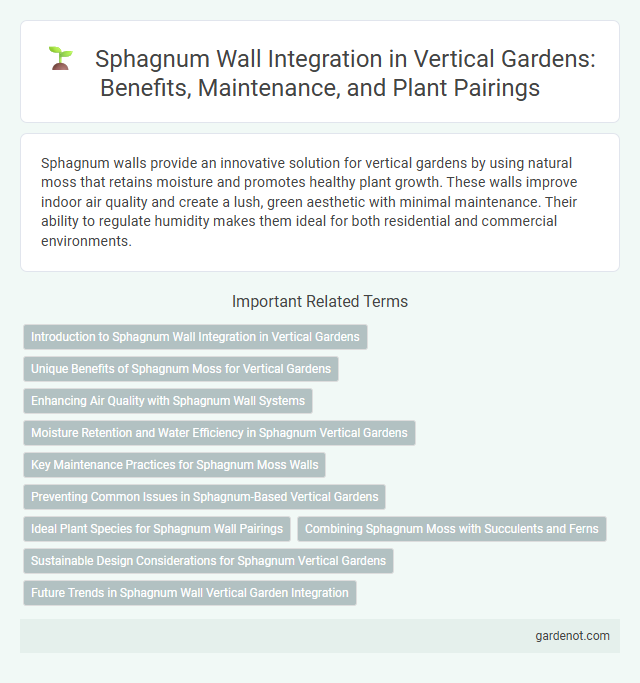Sphagnum walls provide an innovative solution for vertical gardens by using natural moss that retains moisture and promotes healthy plant growth. These walls improve indoor air quality and create a lush, green aesthetic with minimal maintenance. Their ability to regulate humidity makes them ideal for both residential and commercial environments.
Introduction to Sphagnum Wall Integration in Vertical Gardens
Sphagnum wall integration in vertical gardens enhances moisture retention and natural air purification, creating an eco-friendly living display. Sphagnum moss's lightweight structure and excellent water-holding capacity support plant health and reduce maintenance needs. Incorporating sphagnum walls promotes biodiversity while adding texture and vibrant greenery to vertical garden designs.
Unique Benefits of Sphagnum Moss for Vertical Gardens
Sphagnum moss offers exceptional water retention and natural air purification, making it ideal for vertical gardens. Its lightweight, spongy texture provides excellent moisture regulation, reducing watering frequency and promoting healthier plant roots. The moss also acts as a natural antimicrobial barrier, preventing mold and pests, which enhances the longevity and sustainability of vertical garden installations.
Enhancing Air Quality with Sphagnum Wall Systems
Sphagnum wall systems significantly enhance indoor air quality by naturally filtering pollutants and increasing humidity levels. Their dense moss structure efficiently absorbs airborne toxins and dust particles, contributing to a healthier living environment. Incorporating Sphagnum walls in vertical garden designs promotes cleaner air and supports overall well-being.
Moisture Retention and Water Efficiency in Sphagnum Vertical Gardens
Sphagnum walls in vertical gardens excel at moisture retention, absorbing and holding water up to 20 times their weight, which significantly reduces irrigation frequency. Their natural water efficiency supports plant health by maintaining consistent humidity levels and minimizing water runoff. This sustainable moisture management makes sphagnum an ideal substrate for eco-friendly vertical garden installations.
Key Maintenance Practices for Sphagnum Moss Walls
Sphagnum moss walls require consistent moisture levels to prevent drying out and maintain their vibrant appearance. Regular misting and avoiding direct sunlight help preserve the moss's natural texture and color. Periodic inspection for mold or pests ensures the longevity and health of the vertical garden installation.
Preventing Common Issues in Sphagnum-Based Vertical Gardens
Sphagnum walls in vertical gardens effectively retain moisture while preventing root rot and fungal growth through proper irrigation and ventilation. Regular monitoring of humidity levels and ensuring adequate airflow reduces mold and algae buildup on the moss surface. Using high-quality sphagnum moss with natural antimicrobial properties supports plant health by minimizing pest infestations in vertical garden installations.
Ideal Plant Species for Sphagnum Wall Pairings
Ideal plant species for sphagnum wall pairings include moisture-loving epiphytes such as ferns, bromeliads, and orchids, which thrive in the high humidity and acidic conditions provided by sphagnum moss. Mosses like Hypnum and Dicranum complement sphagnum walls by enhancing moisture retention and creating a lush, green backdrop. Small tropical plants such as philodendrons and pothos also adapt well, benefiting from the sphagnum's ability to maintain consistent moisture levels and promote healthy root development.
Combining Sphagnum Moss with Succulents and Ferns
Sphagnum moss walls provide an ideal moisture-retentive base for integrating succulents and ferns, creating a dynamic vertical garden that balances hydration and texture. The sphagnum's natural water retention supports the humidity-loving ferns while allowing succulents to thrive with adequate drainage and aeration. This combination enhances biodiversity and visual appeal, promoting healthy plant growth and sustainability in vertical gardening systems.
Sustainable Design Considerations for Sphagnum Vertical Gardens
Sphagnum walls are integral to sustainable design due to their natural water retention and air purification properties, reducing energy consumption and promoting healthier indoor environments. Utilizing sustainably harvested sphagnum moss ensures minimal ecological impact while enhancing biodiversity in vertical garden installations. Incorporating efficient irrigation systems and lightweight, recyclable substrates further optimize resource use and longevity in sphagnum-based vertical gardens.
Future Trends in Sphagnum Wall Vertical Garden Integration
Sphagnum wall vertical gardens are gaining traction as sustainable green solutions due to their natural moisture retention and air-purifying properties. Emerging trends include integrating smart irrigation systems and sensor technologies to optimize water use and plant health monitoring. Future developments focus on combining eco-friendly materials with modular designs for customizable, space-efficient vertical landscapes in urban environments.
Sphagnum wall Infographic

 gardenot.com
gardenot.com